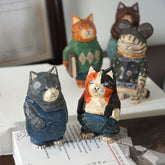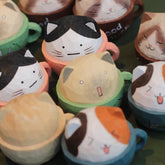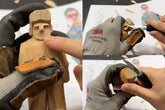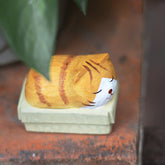How to Carve Humanoid Wooden Gifts: Perfecting the Head-to-Body Ratio
Hey everyone! In the last blog, we gave a basic introduction to the importance of composition and proportion when making human-shaped wooden gifts. In this post, we’re continuing that topic and diving deeper into how head-to-body ratio affects woodcarving work.
Let’s take one of our own wooden gift figurines as an example. The short-legged version is about 11 cm tall, which is roughly a 5.5-head ratio.

Our long-legged version is usually around 6 heads tall. The head is just slightly enlarged. It’s not exactly realistic human proportions, but it’s pretty close, and the body looks more balanced overall.

If you want a figurine like this right away, you can purchase one on our Custom Figurines page. A lot of our customers order custom styles as creative wooden gifts for different holidays.
Back to what we were saying—head-to-body ratio is more of an approximation. You don’t need to stick strictly to whole numbers like 5, 6, 7, or 8. Using rough estimates like 5.5 or 5.3 heads is totally fine. As long as the human figure falls within a reasonable range, the design will meet general aesthetic standards. The key to making great human-shaped wooden gifts is being able to flexibly control full-body proportions.
Let’s take a 7-head ratio as an example and look at the proportion relationships between different body parts for both men and women. You’ll notice that, for both, the upper body and lower body are about the same length. If we mark the pubic bone as the midpoint, the top half is around three heads, and the bottom half is also about three heads.

Now let’s take a look at the arms and legs. The whole arm is roughly this long, and the forearm is actually a little shorter than the upper arm. The wrist usually lines up with the upper thigh or around the pubic bone. It’s fine if it’s a bit higher or lower—doesn’t have to be exact.

Now check out the legs. If you use the knee as the midpoint, the thigh and calf are roughly the same length—just a bit longer than the head.

Since head-to-body ratio is flexible, arm and leg length can also be adjusted. But it’s best to keep the upper arm and forearm, as well as the thigh and calf, roughly equal in proportion.
There’s also a noticeable difference between male and female wood figurines. For women, the shoulders are usually narrower than the hips, giving more of an hourglass or gourd-like shape—wider hips than shoulders. For men, it’s the opposite—they tend to be more of an inverted triangle, with broader shoulders and narrower hips, which gives them a more solid and dimensional look.

If you’re making a male and female figurine to stand together, it’s important to really show the differences between them.
If you’re making cute, cartoon-style figurines, these differences don’t need to be as obvious. Since the heads are oversized, the exact proportions of the body don’t matter as much. The head is the main visual focus, so as long as it’s detailed and expressive, the body can be simplified.











